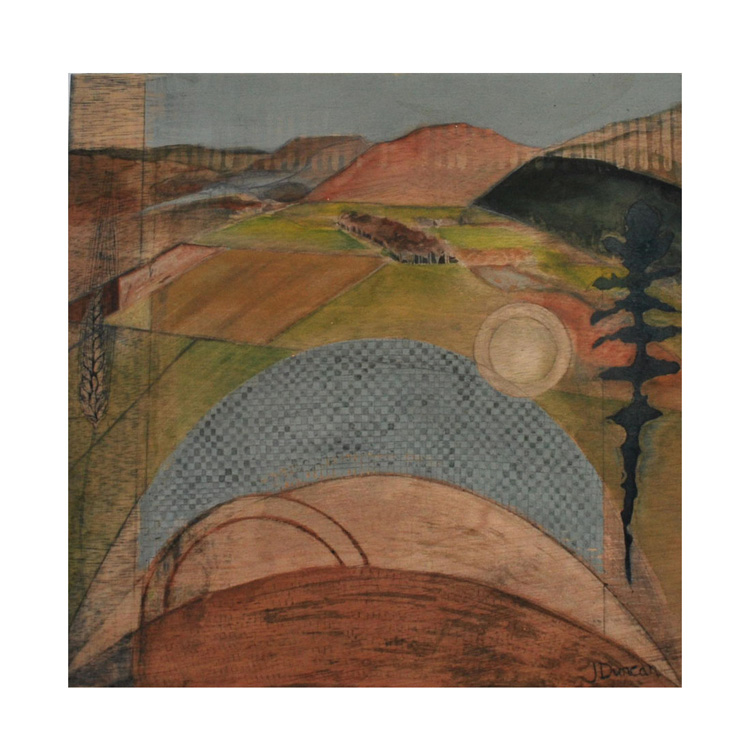
See also Jean’s page , Metamorphosis and Opium Poppy
sustainable croplands

See also Jean’s page , Metamorphosis and Opium Poppy
New series on the yearly cycle in the croplands, based around the quarter days and cross quarter days – check The Year.
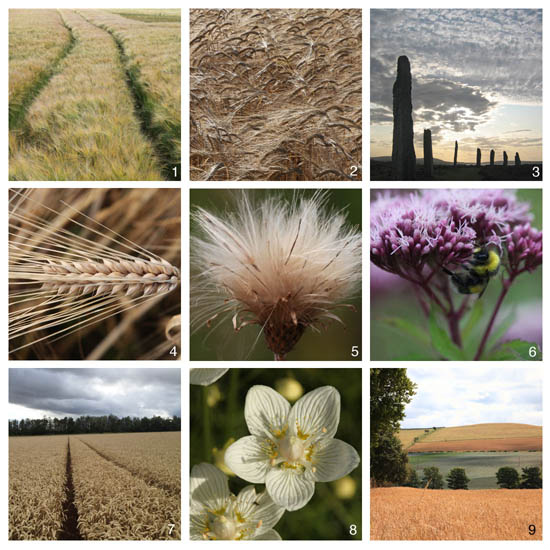
Barley Hordeum vulgare has been grown here as a crop for many thousands of years. Some of the earliest charred remains of seed found in neolithic settlements were of barley. It has not always been the most widely grown corn – oat had that status a century ago – but now barley covers more acres than wheat and much more than oat, its main products whisky and animal food.
Most modern varieties of barley are supplied by seed merchants. The seed for each variety is grown and bulked under controlled conditions that minimise impurity and keep the line genetically uniform, so each has a particular ‘look’ and growth characteristics and suitability for different uses. At one time however, all our crops were maintained as landraces, as seed from one harvest saved for the next. (See What are landraces?) Few landraces remain and one of those is bere barley.
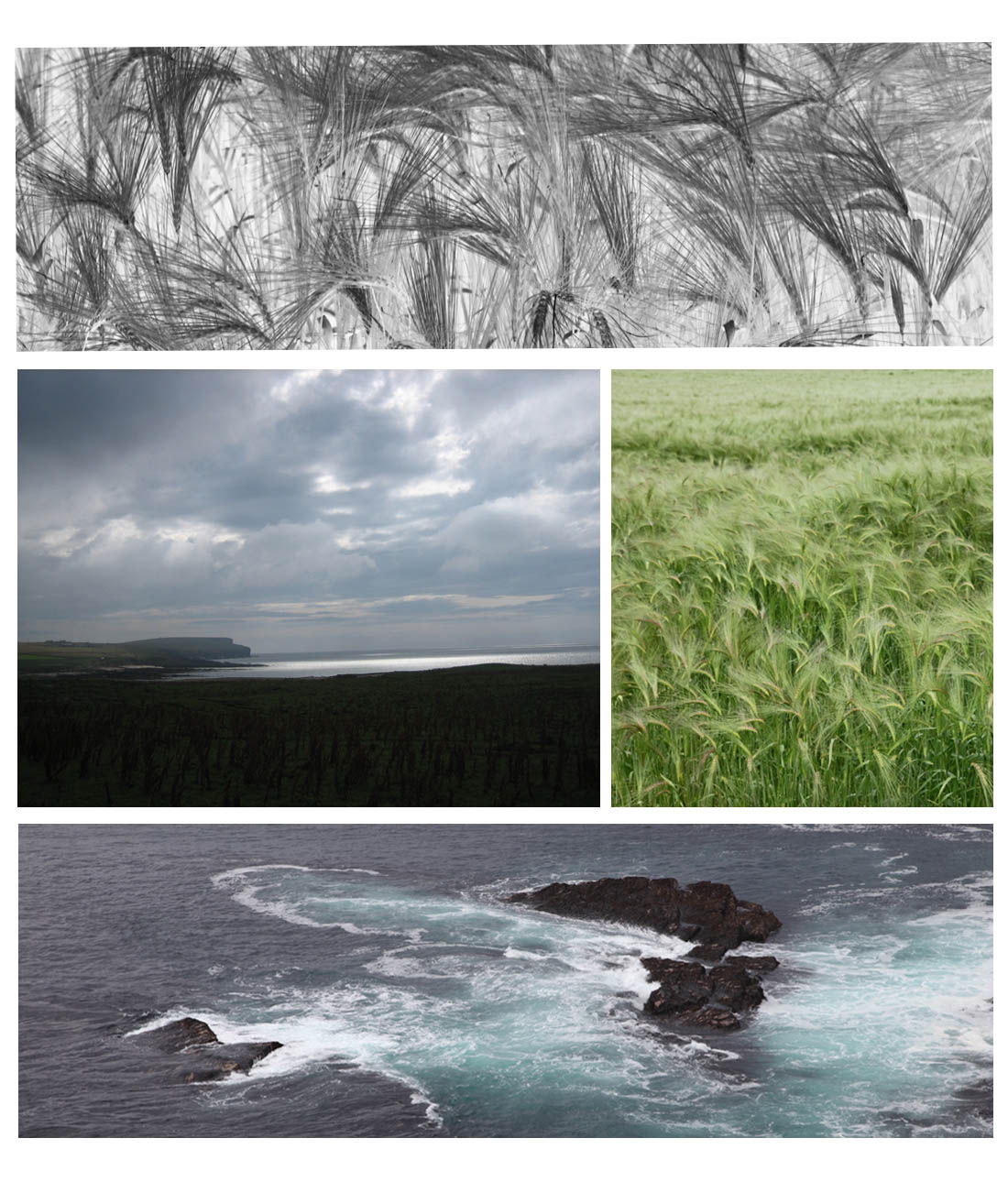
Like all our corn, or cereal, crops, barley started life in the eastern Mediterranean or west Asia when crops were domesticated from wild grasses around 10,000 years ago. From there it came west and north reaching the croplands around 5000 years ago, well after the ice retreated. The earlier Living Field web site had the following paragraph –
“Imagine the small bags of seed, carried overland step by step, century upon century, from its site of domestication to the east of what is now Europe, and then by small boats to Iberia, then Brittany and north to the stone age settlements of the north-east Atlantic coasts, or else by other routes through central Europe and across the North Sea. How many times must those bags have perished and how many times must the boatman have reached dry land to see the seed rotted and the crops fail. And yet, 5000 years or more later, we still have a landrace of barley, known as bere (sounding in the north more like bear than beer) and still grown for special food and drink.”
When you see or experience the seas around Orkney (images above) and the other islands, you wonder how our early settlers managed to get here carrying bags of grain in their small boats.
Is there a continuous ‘bere line’ from the stone age? There can be no certainty. Landraces can be erased by natural calamities, or by peoples moving or changing their way of life. When a seed stock was lost, it might have taken centuries for new seed to be brought in. Later, waves of migrants from south and east would have brought their own seed with them. Where the new seed came from is not clear. What we can say is that the bere still grown today is very different from modern varieties.
In Lawson & Son’s catalogue of 1852, bere or rough barley, was listed among the four-row barleys. Most of the barleys at that time were two-row. The number of rows refers to the alignment of grain on the ear, obvious when you see it in two- and six-row types.
The four-row types, as Lawson and Son suggest, are probably better classified as structural variants of the six-row types. But the four-rows look different from the six-rows, so on the Living Field site, we will continue to call bere four-row. In the rough and tumble of subsistence agriculture over the millennia, the bere landrace, maintained as harvested seed saved from year to year, must have contained at various times, as well as the four-row, two- and six-row types within it. Purity is not a feature of landraces.
Bere has now almost disappeared except in some remote corners and most commercial fields you will see are two-row. Yet bere has great significance as a traditional crop, a true heritage and a possible source of genetic material for future crops.
Barony Mills, Birsay Orkney, showing interior, old grinding wheel, tackle, water wheel with new wooden paddles, 2011 (Squire)
A landrace of barley is still grown and used in a few places, notably in Orkney, where fields are gown each year to supply grain to the Barony Mills, near Birsay (images above). When the grain starts to fill and ripen, it has strong, characteristic red bands on the outer husk of the grain (images below) and long, tough awns.
As in most barleys, the protective coating around the grain does not fall off after harvest (as it does in modern wheat, for example), so the husks and awns have to be removed to get the bere meal (flour). Once, bere grain and other corn was ground between stones, then in stone saddle querns and later by hand-turned stone wheels, one on top of the other, and then by great mechanised grindstones powered by wind or water.
The Barony Mills in Orkney grind local bere grain into flour by great water-powered wheels. The Mills sell bere meal to the public (web link below). Bere grain is also sold to a few distilleries to add that something to the malt whiskey.
Barony Mills is an excellent place – an essential visit for anyone interested in rare grain and flour and living industrial heritage; and if it’s spring or summer, ask for directions to the bere fields.
The garden has grown bere for several years. The crop is grown in the Garden as a landrace – seed is harvested, saved over the winter and sown the next spring.
The bere seed germinates quickly, after just a few days, and once outside is vigorous in its vegetative phase and then flowers and seeds profusely. As a seed stock it does not give any problems and requires no special treatment. As with all seed, it has to be kept dry between harvest and the next sowing.
The red striping on the outer husk, or covering of the grain, is visible upper right and lower left below. The seeding ‘ears’ tend to bend and together the awns form an asymmetrical fan, visible in the image at the top of the page and in the one upper left below.
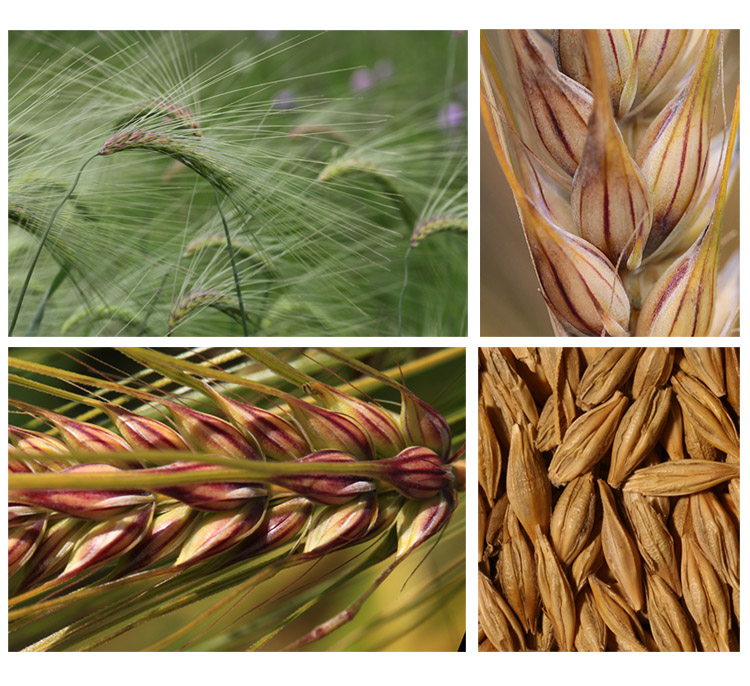
Each year, a few two-row plants emerge in the bere. They could be impurities introduced from commercial varieties grown in the garden? We take them out to preserve the general bere character.
Growing bere and other landraces in the Garden has been rewarding for the team and brought great interest among visitors. We start it off in April, it begins to flower in early June and is ready for harvest usually in August. It does not seem to have changed much in the last 180 years: Lawson and Son, in their experimental trials of 1835, record they sowed it on 7 April and it matured on 12 August after 127 days.
The Living Field’s original bere seed was given to us by the Agronomy Unit at Orkney College. For which, many thanks. Barony Mills, Birsay, Orkney, also gave us a couple of bags of grain. We have bought flour from them for demonstrations at various open days. Thanks to miller Rae Philips for advice.
Gladys Wright, Linda Ford and Jackie Thompson grow the bere crops and maintain the seed stocks for the Living Field garden. Text and images by Geoff Squire (unless stated).
Dickson C, Dickson J. 2000. Plants and people in ancient Scotland. Tempus Publishing, Stroud, Gloucestershire.
Fenton A (ed). 2007. The food of the Scots. Volume 5 in A Compendium of Scottish Ethnology. Publisher: John Donald. (Describes the many uses of bere meal).
Fenton A (ed). 2011. Farming and the land. Volume 2 in A Compendium of Scottish Ethnology. Publisher: John Donald. (Many references to growing bere.)
Lawson P and Son. 1852. Synopsis of the Vegetable Products of Scotland. Edinburgh: Private Press of Peter Lawson and Son.
The bere line – rhymes with hairline – random notes on the origin and nature of bere, including Thorburn’s Diagrams – acreage and yield or bere and barley in the mid-1800s, and Bere, bear, bair, beir, bygg – names for bere in Old Scots, (also links to article with old names and for other cereals).
What are landraces? – introduction to crop landraces.
Barony Mills, Orkney: http://www.birsay.org.uk/baronymill.htm.
Argo’s Bakery, Stromness: http://www.argosbakery.co.uk
And see the page on miller Rae Phillips at Slow Food UK: http://www.slowfood.org.uk/ff-producers/producer-rae-phillips-barony-mills-beremeal/
Orkney College, Agronomy Institute: http://www.agronomy.uhi.ac.uk
SASA Science and Advice for Scottish Agriculture (previously Scottish Agricultural Science Agency or ‘East Craigs’): Scottish landraces and traditional varieties
Botanical name
The botanical or latin name Hordeum vulgare is used on this web site to cover all types of two-, four- and six-row cultivated barley. Some taxonomies separate the two- and six-row as different species, but where does that leave the four-row? Others suggest they are are better classed as sub-species of Hordeum vulgare.
Author/contact: geoff.squire@hutton.ac.uk
[Last update 13 September 2016]
Before modern genetics and breeding, before the world’s great stores of genetic resources were built and before the purity of crop varieties could be certified using DNA tests, most crops were kept as landraces.
Seed of wheat, oat, barley, beans and all the other crops was usually highly variable, the individuals genetically different. When sown in a field in a year, those individuals that survived and yielded the most were those best fitted to the conditions. These fitter plants contributed more to the harvested seed than their less fit neighbours. Samples of seed were kept and then sown the next season. Again, plants that were most fitted survived and reproduced.
Gradually the nature of the seed changed by this repeated selection to track the local environment and growing conditions. This would have happened as the early cereals, legumes, fibres and oils were carried westwards and northwards from their Asian centres of origin to the margins of the Atlantic. Landraces evolved to cope with low soil fertility, a cold wet winter and the local pests, and would have split into recognisable types, known to belong to an area of land or method of farming.
But with little warning, a crop could be wiped out by extreme events, the farmers left with just a fragment, or none, of the seed they had nurtured for years, decades even. Maintaining a landrace was no easy matter. Many would have disappeared, others changed to adapt to new conditions.
Landraces are not a thing of the past. They are common in Africa and large parts of Asia today. Under-used and under-researched crops such as bambara Vigna subterranea exist mostly as landraces, each typical of a region and maintained by seed saved from one year to the next.
Not so long ago in our Islands, crops were maintained as landraces, and the practice persists (see below), though most crops are now sown from bags of named varieties, each bought from a seed supplier, certified and uniform and generally high yielding.
More on this web site: Landrace 1 – bere
The Synopsis of Vegetable Products of Scotland, prepared by the Edinburgh seedsmen Peter Lawson and Son in 1852 consists largely of named ‘types’ of cereals, legumes, fibres, fruit and all the other crops, but the types are not what would be considered true varieties today. Among the wheats, there were 142 types recorded, the barleys 42 and the oats 53 – each named with usually some note on their origin.
Some of the types on the list were recently imported, for instance, from the Baltic, from France, from the low countries, from England. But many of the notes suggest types were found and maintained by individual farmers in specific regions.
So there is the Hopetoun wheat “the produce of single ear of an unusual size … discovered in 1832, on Mr Reid’s farm of Drem, East Lothian … [which was passed through several farming hands and] … is now pretty widely distributed amongst growers ….”.
Or the St Madoes barley “discovered, in 1838, by the Rev. Mr. Noble of St Madoes, in a field of the Dunlop [another type of barley]; and is evidently of a very different kind … a recommendation in damp climates …” .
And then Dyock’s Early oat ” originally raised by a Mr Dyock, near Aberdeen, and has been grown in the vicinity of Brechin …. it is hardy, early, very prolific, and exceedingly well adapted for the higher corn lands”.
Most of those old cereal types are no longer with us, lost in the march towards modern varietal uniformity, but what the Lawson list shows clearly is the vigour and intent of farmers working 100-200 years ago in their search for better crop seed, better for their region and purposes, better adapted to their conditions; and then the bulking and trialling of a new type over a few seasons, and the passing on of the good material to others.
A few farmers save seed – it avoids buying it every year. (Possibly many more save it than would admit!) Yet not many landraces remain here – the traditional barley, bere, was recorded in the Lawson list as a four-row type, “chiefly grown in the Highlands of Scotland and in the lowlands on exposed inferior light soils”. Bere remains with us in a few places, notably Orkney.
There are also landraces of wheat and rye in certain collections and black oat must still persist mainly as a landrace.
The Living Field grows bere, and landraces of wheat, rye and black oat every year to compare them with modern varieties. We save seed at the end of the year, keep it safe over the winter and sow it as a new crop next spring. All four types germinate well and grow fast. They are different from their modern relatives, often taller, rangier, weedier.
Articles on the cereal landraces will appear on the Living Field web site in the coming weeks.
Lawson P and Son. 1982. Synopsis of the Vegetable Products of Scotland. Edinburgh: private press of Peter Lawson and Son.
Author/contact: geoff.squire@hutton.ac.uk
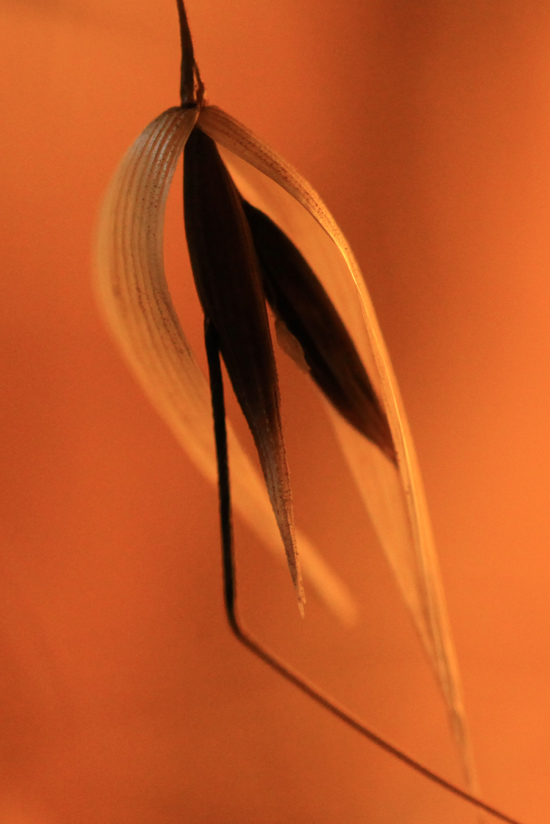
A new series begins today on Landraces – crops perpetuated by seed saved from year to year, and by this means adapting to local conditions. Related: What are landraces? Landrace 1 – bere.
Science and Art working together through a Dundee CECHR Change Maker Workshop, organised by artist Jean Duncan, hosted at the Living Field cabins and garden on 2 October 2014: food security, environmental degradation, sustainable agriculture. More to follow.